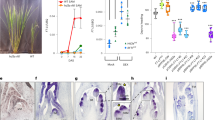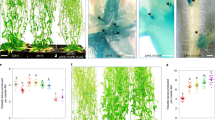Abstract
Flowering plants perceive photoperiodic signals in leaves to generate mobile stimuli required for the induction of flower formation at shoot apices. Although FLOWERING LOCUS T (FT) has been identified as part of the mobile floral stimuli in Arabidopsis thaliana, the mechanisms underlying long-distance movement of FT from leaves to shoot apices remain largely unclear. Here we show that a heavy-metal-associated (HMA) domain-containing protein, SODIUM POTASSIUM ROOT DEFECTIVE 1 (NaKR1), is activated by CONSTANS (CO) under long-day conditions and regulates long-distance movement of FT in Arabidopsis. Loss of function of NaKR1 compromises FT transport to shoot apices through sieve elements, causing late flowering under long-day conditions. NaKR1 and FT share similar expression patterns and subcellular localization, and interact with each other in vivo. Grafting experiments demonstrate that NaKR1 promotes flowering through mediating FT translocation from leaves to shoot apices. Thus, photoperiodic control of floral induction requires NaKR1-mediated long-distance delivery of florigenic signals.
This is a preview of subscription content, access via your institution
Access options
Subscribe to this journal
Receive 12 digital issues and online access to articles
$119.00 per year
only $9.92 per issue
Buy this article
- Purchase on Springer Link
- Instant access to full article PDF
Prices may be subject to local taxes which are calculated during checkout






Similar content being viewed by others
References
Knott, J. E. Effect of localized photoperiod on spinach. Proc. Am. Soc. Hortic. Sci. 31, 152–154 (1934).
Chailakhyan, M. K. New facts in support of the hormonal theory of plant development. Compt. Rend. Acad. Sci. URSS 13, 79–83 (1936).
Corbesier, L. et al. FT protein movement contributes to long-distance signaling in floral induction of Arabidopsis. Science 316, 1030–1033 (2007).
Jaeger, K. E. & Wigge, P. A. FT protein acts as a long-range signal in Arabidopsis. Curr. Biol. 17, 1050–1054 (2007).
Mathieu, J., Warthmann, N., Küttner, F. & Schmid, M. Export of FT protein from phloem companion cells is sufficient for floral induction in Arabidopsis. Curr. Biol. 17, 1055–1060 (2007).
Tamaki, S., Matsuo, S., Wong, H. L., Yokoi, S. & Shimamoto, K. Hd3a protein is a mobile flowering signal in rice. Science 316, 1033–1036 (2007).
Lin, M.-K. et al. FLOWERING LOCUS T protein may act as the long distance florigenic signal in the cucurbits. Plant Cell 19, 1488–1506 (2007).
Lifschitz, E. et al. The tomato FT ortholog triggers systemic signals that regulate growth and flowering and substitute for diverse environmental stimuli. Proc. Natl Acad. Sci. USA 103, 6398–6403 (2006).
Wigge, P. A. et al. Integration of spatial and temporal information during floral induction in Arabidopsis. Science 309, 1056–1059 (2005).
Suarez-Lopez, P. et al. CONSTANS mediates between the circadian clock and the control of flowering in Arabidopsis. Nature 410, 1116–1120 (2001).
An, H. et al. CONSTANS acts in the phloem to regulate a systemic signal that induces photoperiodic flowering of Arabidopsis. Development 131, 3615–3626 (2004).
Samach, A. et al. Distinct roles of CONSTANS target genes in reproductive development of Arabidopsis. Science 288, 1613–1616 (2000).
Takada, S. & Goto, K. TERMINAL FLOWER2, an Arabidopsis homolog of HETEROCHROMATIN PROTEIN1, counteracts the activation of FLOWERING LOCUS T by CONSTANS in the vascular tissues of leaves to regulate flowering time. Plant Cell 15, 2856–2865 (2003).
Liu, L. et al. FTIP1 is an essential regulator required for florigen transport. PLoS Biol. 10, e1001313 (2012).
Abe, M. et al. FD, a bZIP protein mediating signals from the floral pathway integrator FT at the shoot apex. Science 309, 1052–1056 (2005).
Kardailsky, I. et al. Activation tagging of the floral inducer FT. Science 286, 1962–1965 (1999).
Kobayashi, Y., Kaya, H., Goto, K., Iwabuchi, M. & Araki, T. A pair of related genes with antagonistic roles in mediating flowering signals. Science 286, 1960–1962 (1999).
Tehseen, M., Cairns, N., Sherson, S. & Cobbett, C. S. Metallochaperone-like genes in Arabidopsis thaliana. Metallomics 2, 556–564 (2010).
de Abreu-Neto, J. B., Turchetto-Zolet, A. C., de Oliveira, L. F. V., Bodanese Zanettini, M. H. & Margis-Pinheiro, M. Heavy metal-associated isoprenylated plant protein (HIPP): characterization of a family of proteins exclusive to plants. FEBS J. 280, 1604–1616 (2013).
Tian, H. et al. Arabidopsis NPCC6/NaKR1 is a phloem mobile metal binding protein necessary for phloem function and root meristem maintenance. Plant Cell 22, 3963–3979 (2010).
Suzuki, N., Yamaguchi, Y., Koizumi, N. & Sano, H. Functional characterization of a heavy metal binding protein CdI19 from Arabidopsis. Plant J. 32, 165–173 (2002).
Gao, W., Xiao, S., Li, H.-Y., Tsao, S.-W. & Chye, M.-L. Arabidopsis thaliana acyl-CoA-binding protein ACBP2 interacts with heavy-metal-binding farnesylated protein AtFP6. New Phytol. 181, 89–102 (2009).
Barth, O., Vogt, S., Uhlemann, R., Zschiesche, W. & Humbeck, K. Stress induced and nuclear localized HIPP26 from Arabidopsis thaliana interacts via its heavy metal associated domain with the drought stress related zinc finger transcription factor ATHB29. Plant Mol. Biol. 69, 213–226 (2009).
Zhang, C., Barthelson, R. A., Lambert, G. M. & Galbraith, D. W. Global characterization of cell-specific gene expression through fluorescence-activated sorting of nuclei. Plant Physiol. 147, 30–40 (2008).
Brady, S. M. et al. A high-resolution root spatiotemporal map reveals do expression patterns. Science 318, 801–806 (2007).
Deeken, R. et al. Identification of Arabidopsis thaliana phloem RNAs provides a search criterion for phloem-based transcripts hidden in complex datasets of microarray experiments. Plant J. 55, 746–759 (2008).
Schwab, R., Ossowski, S., Riester, M., Warthmann, N. & Weigel, D. Highly specific gene silencing by artificial microRNAs in Arabidopsis. Plant Cell 18, 1121–1133 (2006).
Hou, X. et al. Nuclear factor Y-mediated H3K27me3 demethylation of the SOC1 locus orchestrates flowering responses of Arabidopsis. Nature Commun. 5, 4601 (2014).
Tiwari, S. B. et al. The flowering time regulator CONSTANS is recruited to the FLOWERING LOCUS T promoter via a unique cis-element. New Phytol. 187, 57–66 (2010).
Imlau, A., Truernit, E. & Sauer, N. Cell-to-cell and long-distance trafficking of the green fluorescent protein in the phloem and symplastic unloading of the protein into sink tissues. Plant Cell 11, 309–322 (1999).
Nelson, B. K., Cai, X. & Nebenführ, A. A multicolored set of in vivo organelle markers for co-localization studies in Arabidopsis and other plants. Plant J. 51, 1126–1136 (2007).
Yamaguchi, A., Kobayashi, Y., Goto, K., Abe, M. & Araki, T. TWIN SISTER OF FT (TSF) acts as a floral pathway integrator redundantly with FT. Plant Cell Physiol. 46, 1175–1189 (2005).
Yoo, S. J., Hong, S. M., Jung, H. S. & Ahn, J. H. The cotyledons produce sufficient FT protein to induce flowering: evidence from cotyledon micrografting in Arabidopsis. Plant Cell Physiol. 54, 119–128 (2013).
Notaguchi, M. et al. Long-distance, graft-transmissible action of Arabidopsis FLOWERING LOCUS T protein to promote flowering. Plant Cell Physiol. 49, 1645–1658 (2008).
Bernier, G., Havelange, A., Houssa, C., Petitjean, A. & Lejeune, P. Physiological signals that induce flowering. Plant Cell 5, 1147–1155 (1993).
Wahl, V. et al. Regulation of flowering by trehalose-6-phosphate signaling in Arabidopsis thaliana. Science 339, 704–707 (2013).
Clough, S. J. & Bent, A. F. Floral dip: a simplified method for Agrobacterium-mediated transformation of Arabidopsis thaliana. Plant J. 16, 735–743 (1998).
Liu, C. et al. Specification of Arabidopsis floral meristem identity by repression of flowering time genes. Development 134, 1901–1910 (2007).
Chen, L., Wang, F., Wang, X. & Liu, Y.-G. Robust one-tube Ω-PCR strategy accelerates precise sequence modification of plasmids for functional genomics. Plant Cell Physiol. 54, 634–642 (2013).
Li, D. et al. A repressor complex governs the integration of flowering signals in Arabidopsis. Dev. Cell 15, 110–120 (2008).
Yu, H., Yang, S. H. & Goh, C. J. DOH1, a class 1 knox gene, is required for maintenance of the basic plant architecture and floral transition in orchid. Plant Cell 12, 2143–2159 (2000).
Sparkes, I. A., Runions, J., Kearns, A. & Hawes, C. Rapid, transient expression of fluorescent fusion proteins in tobacco plants and generation of stably transformed plants. Nature Protoc. 1, 2019–2025 (2006).
Wilson, S. M. & Bacic, A. Preparation of plant cells for transmission electron microscopy to optimize immunogold labeling of carbohydrate and protein epitopes. Nature Protoc. 7, 1716–1727 (2012).
Acknowledgements
We thank J. M. Ward for providing nakr1-1 seeds. This work was supported by Academic Research Funds (MOE2011-T2-2-008) from the Ministry of Education, Singapore, the Singapore National Research Foundation Investigatorship Programme (NRF-NRFI2016-02) and intramural research support from National University of Singapore and Temasek Life Sciences Laboratory.
Author information
Authors and Affiliations
Contributions
Y.Z. and H.Y. conceived and designed the study. Y.Z., L.L. and L.S. performed the experiments. Y.Z., L.S. and H.Y. analysed data and wrote the paper.
Corresponding author
Ethics declarations
Competing interests
The authors declare no competing financial interests.
Supplementary information
Supplementary Information
Supplementary Figs 1-12, Supplementary Table 1, and Supplementary Materials and Methods. (PDF 3220 kb)
Rights and permissions
About this article
Cite this article
Zhu, Y., Liu, L., Shen, L. et al. NaKR1 regulates long-distance movement of FLOWERING LOCUS T in Arabidopsis. Nature Plants 2, 16075 (2016). https://doi.org/10.1038/nplants.2016.75
Received:
Accepted:
Published:
DOI: https://doi.org/10.1038/nplants.2016.75
This article is cited by
-
The genome of Aechmea fasciata provides insights into the evolution of tank epiphytic habits and ethylene-induced flowering
Communications Biology (2022)
-
Comparative analysis of buds transcriptome and identification of two florigen gene AkFTs in Amorphophallus konjac
Scientific Reports (2022)
-
Nitrogen as a regulator for flowering time in plant
Plant and Soil (2022)
-
The sugar transporter SWEET10 acts downstream of FLOWERING LOCUS T during floral transition of Arabidopsis thaliana
BMC Plant Biology (2020)
-
Cut and paste: temperature-enhanced cotyledon micrografting for Arabidopsis thaliana seedlings
Plant Methods (2020)



